

Natural Disasters - Forest fire. Blizzards - Earthquake - Flood - Forest fire - Hurricanes - Tornado - Tsunami - Volcano A forest fire is a natural disaster consisting of a fire which destroys a forested area, and can be a great danger to people who live in forests as well as wildlife.

Forest fires are generally started by lightning, but also by human negligence or arson, and can burn thousands of square kilometers. Forest fires, also known as wildfires, vegetation fire, grass fire, brush fire or bush fire, is common in vegetated areas of Australia, South Africa, United States and Canada, where climates are sufficiently moist to allow the growth of trees, but feature extended hot and dry periods. Forest fires are caused by the drying out of branches, leaves and therefore becomes highly flammable. Fires can do weird things including: Crawling - spreads from bush to bush Crown - spread at an incredible pace through the top of the forest.
Examples: Oakland Hills firestorm. Back to Main Page. Threats to the Rainforests. Amazon Rainforest deforestation. WWF Rainforest: Deforestation Effects. Deforestation. A deforested area Deforestation is when forests are lost and not replanted.
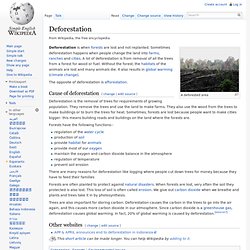
Sometimes deforestation happens when people change the land into farms, ranches and cities. A lot of deforestation is from removal of all the trees from a forest for wood or fuel. Without the forest, the habitats of the animals are lost and many animals die. It also results in global warming (climate change). The opposite of deforestation is afforestation. Deforestation Facts, Deforestation Information, Effects of Deforestation. Modern-Day Plague Deforestation is clearing Earth's forests on a massive scale, often resulting in damage to the quality of the land.
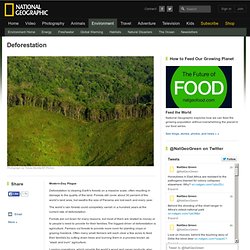
Forests still cover about 30 percent of the world’s land area, but swaths the size of Panama are lost each and every year. The world’s rain forests could completely vanish in a hundred years at the current rate of deforestation. Forests are cut down for many reasons, but most of them are related to money or to people’s need to provide for their families.The biggest driver of deforestation is agriculture.
Farmers cut forests to provide more room for planting crops or grazing livestock. Logging operations, which provide the world’s wood and paper products, also cut countless trees each year. Not all deforestation is intentional. Deforestation has many negative effects on the environment. Rain Forest Threats, Rain Forest Species. More than half of Earth’s rain forests have already been lost forever to the insatiable human demand for wood and arable land.

Rain forests that once grew over 14 percent of the land on Earth now cover only about 6 percent. And if current deforestation rates continue, these critical habitats could disappear from the planet completely within the next hundred years. The reasons for plundering rain forests are mainly economic. Wealthy nations drive demand for tropical timber, and cash-strapped governments often grant logging concessions at a fraction of the land’s true value. “Homesteader” policies also encourage citizens to clear-cut forests for farms. Threats Solutions. Deforestation. Forests cover 31% of the land area on our planet.

They produce vital oxygen and provide homes for people and wildlife. Many of the world’s most threatened and endangered animals live in forests, and 1.6 billion people rely on benefits forests offer, including food, fresh water, clothing, traditional medicine and shelter. But forests around the world are under threat from deforestation, jeopardizing these benefits. Deforestation comes in many forms, including fires, clear-cutting for agriculture, ranching and development, unsustainable logging for timber, and degradation due to climate change. This impacts people’s livelihoods and threatens a wide range of plant and animal species. Forests play a critical role in mitigating climate change because they act as a carbon sink—soaking up carbon dioxide that would otherwise be free in the atmosphere and contribute to ongoing changes in climate patterns. WWF has been working to protect forests for more than 50 years. Why is slash-and-burn deforestation particularly harmful. In heavily forested areas, or those with little usable soil for farming, natives often turn to slash-and-burn deforestation to feed their families.
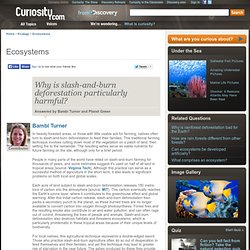
This traditional farming technique involves cutting down most of the vegetation on a patch of land, then setting fire to the remainder. The resulting ashes serve as viable nutrients for future farming on the site, although only for a brief period. People in many parts of the world have relied on slash-and-burn farming for thousands of years, and some estimates suggest it's used on half of all land in tropical areas [source: Virginia Tech]. Although this practice can serve as a successful method of agriculture in the short term, it also leads to significant problems on both local and global scales. Each acre of land subject to slash-and-burn deforestation releases 180 metric tons of carbon into the atmosphere [source: MIT]. CNN Explains: Deforestation. Illegal logging. Illegal logging threatens some of the most valuable forests globally – from the Amazon to the Russian Far East.
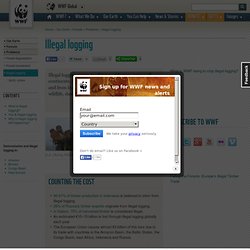
And yet, for many of the people that live in these forests, illegal logging is a vital source of income - sometimes it is the only way to survive. But at other times it threatens their lives. Increased demand for forests products has brought some financial benefits for poor people living near to forests. But there is also evidence to show that usually, poor communities who are completely dependent on forests lose out to powerful interests, logging companies and migrant workers who reap most of the benefits. How does this happen? US$1 for a villager, US$10 from your wallet For example, a small community in Papua Province, Indonesia, can receive approximately US$11 for a cubic metre of hardwood. As a finished product, waiting to be bought on a furniture shop rack in a EU country or the US, this cubic metre will be worth 10 times that much. Deforestation Facts, Deforestation Information, Effects of Deforestation.
Modern-Day Plague Deforestation is clearing Earth's forests on a massive scale, often resulting in damage to the quality of the land.

Forests still cover about 30 percent of the world’s land area, but swaths the size of Panama are lost each and every year. The world’s rain forests could completely vanish in a hundred years at the current rate of deforestation. Forests are cut down for many reasons, but most of them are related to money or to people’s need to provide for their families.The biggest driver of deforestation is agriculture. Farmers cut forests to provide more room for planting crops or grazing livestock.
Logging operations, which provide the world’s wood and paper products, also cut countless trees each year. WWF: Deforestation Main Page. Forests cover 31% of the land area on our planet.
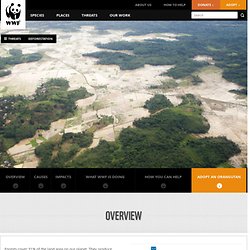
Deforestation. The Double Whammy of Deforestation Deforestation by burning, a widespread practice in the world’s tropical rain forests, adversely impacts the trace-gas composition of the atmosphere in two different ways.
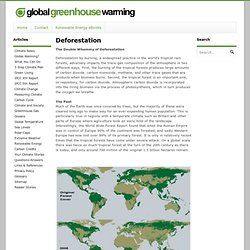
Deforestation.